Choosing the Right AC Grill Design: A Blend of Style and Functionality

Selecting the right air conditioning (AC) grill design is essential for optimizing both airflow efficiency and interior aesthetics in residential and commercial spaces. AC grills come in various types, including linear bar grills, supply grills, return grills, diffusers, round ceiling grills, square swirl grills, egg crate grills, and floor grills. Each serves a distinct function while complementing the overall decor.
Key Considerations in AC Grill Selection:
- Material & Durability – Choices range from aluminum and cast iron for longevity to plastic for affordability and moisture resistance.
- Installation & Sizing – Proper placement and sizing prevent airflow inefficiencies and temperature inconsistencies.
- Aesthetic Appeal – Customizable designs, colors, and finishes enhance interior integration.
- Brand & Quality – Opting for reputable manufacturers ensures durability and post-installation support.
Room Characteristics & Their Impact on AC Grills:
- Room Size & Ceiling Height – Larger rooms and higher ceilings demand more or larger grills to maintain airflow efficiency.
- Layout & Airflow Considerations – Strategic grill placement prevents restricted airflow and enhances temperature distribution.
Striking the Right Balance: While decorative grills offer visual appeal, they must not compromise airflow efficiency. Thoughtful ventilation considerations and color coordination can help blend AC grills seamlessly into interior designs while ensuring optimal HVAC performance.
By navigating these factors, homeowners and professionals can achieve a perfect synergy between style, comfort, and efficiency in their HVAC systems.
Customization and Personalization
With the growing demand for personalized home and office decor, AC grills are now available in a variety of customizable designs. Homeowners can opt for unique patterns, intricate laser-cut designs, or even brand-specific logos on grills to maintain brand consistency in commercial environments. These customizable options enhance the visual appeal of HVAC components while ensuring that functionality remains uncompromised.
Smart AC Grills: The Future of Airflow Management
As technology continues to advance, smart AC grills are gaining traction. These grills feature motorized louvers that adjust airflow automatically based on temperature and humidity levels, optimizing comfort and energy efficiency. Some models even integrate with smart home systems, allowing users to control airflow settings via mobile apps or voice assistants like Alexa and Google Assistant. The adoption of smart AC grills aligns with the broader trend of IoT-driven home automation, enhancing convenience and sustainability.
Sustainability and Eco-Friendly Materials
Environmental concerns have led to the increasing use of eco-friendly materials in AC grills. Recycled aluminum, bamboo, and biodegradable plastics are becoming popular choices for sustainable HVAC solutions. These materials not only reduce environmental impact but also offer durability and resistance to wear and tear. Additionally, energy-efficient AC grills designed to minimize air resistance contribute to lower HVAC energy consumption, making them a preferred option for green building initiatives.
Installation and Maintenance Best Practices
Proper installation and regular maintenance of AC grills are crucial to ensuring optimal HVAC performance. Some key best practices include:
- Correct Placement: Positioning supply and return grills strategically to prevent airflow obstructions and maintain consistent air circulation.
- Routine Cleaning: Dust and debris can accumulate in AC grills over time, affecting airflow and reducing system efficiency. Regular cleaning with a vacuum or damp cloth helps maintain performance.
- Filter Integration: Some advanced AC grills come with built-in air filters that enhance indoor air quality by trapping dust, allergens, and pollutants. Ensuring these filters are regularly replaced can improve both air quality and system efficiency.
- Professional Inspection: Periodic check-ups by HVAC professionals can help identify potential airflow issues and prevent costly repairs down the line.
Conclusion
Choosing the right AC grill design involves more than just aesthetics—it requires a careful balance between functionality, efficiency, and style. With an expanding market that offers customizable, smart, and sustainable options, homeowners and businesses have a wide array of choices to enhance both the appearance and performance of their HVAC systems.
By considering factors such as material quality, installation requirements, airflow efficiency, and design preferences, one can select an AC grill that not only complements the space but also contributes to a comfortable and energy-efficient environment.
